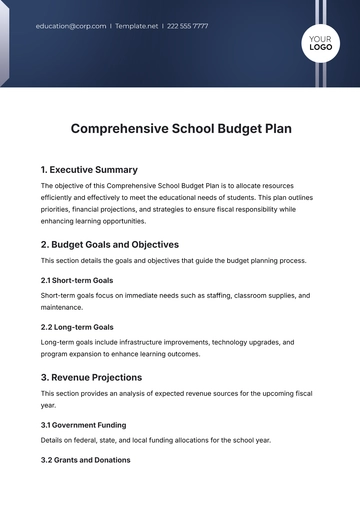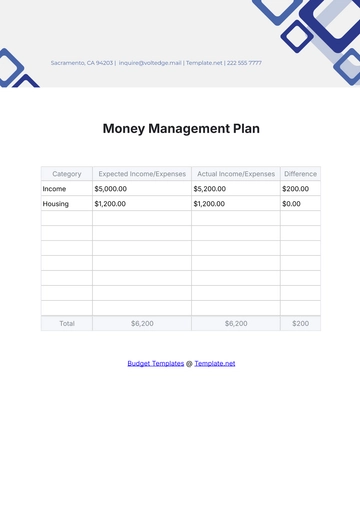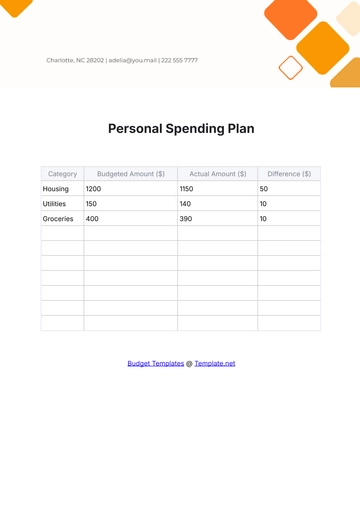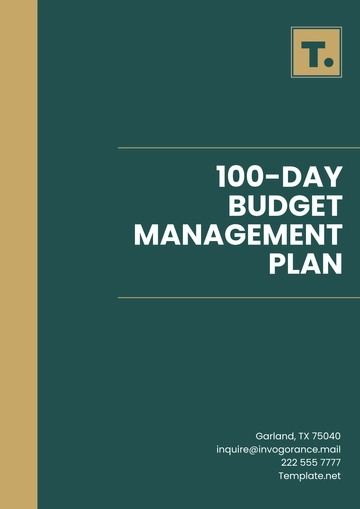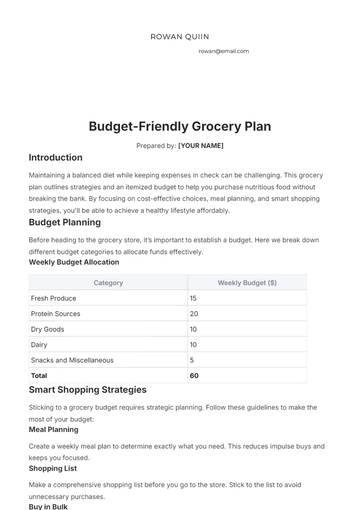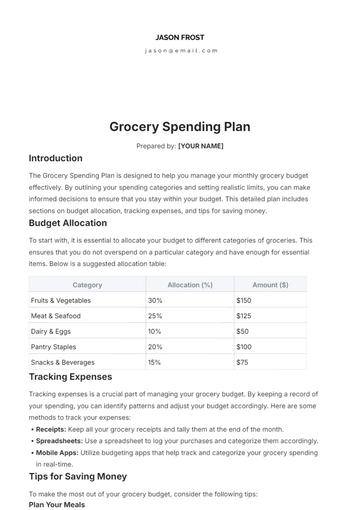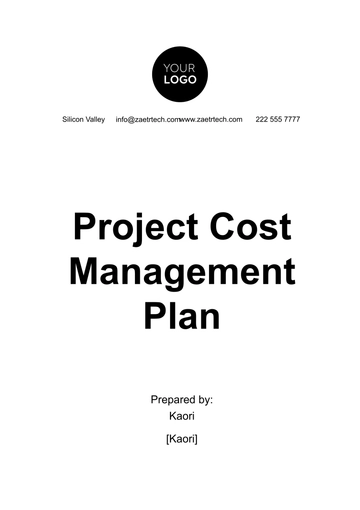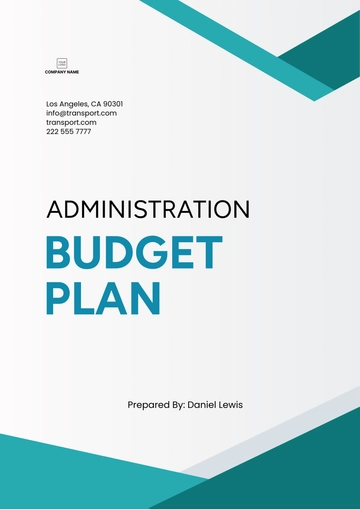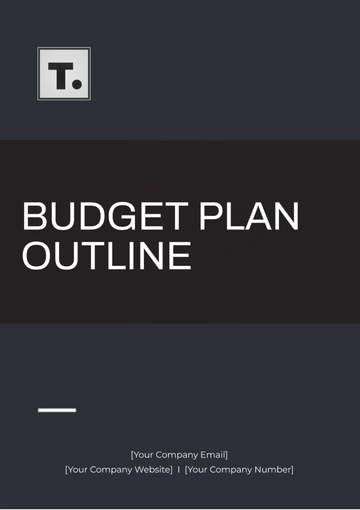Free Finance Budget Restructuring Plan
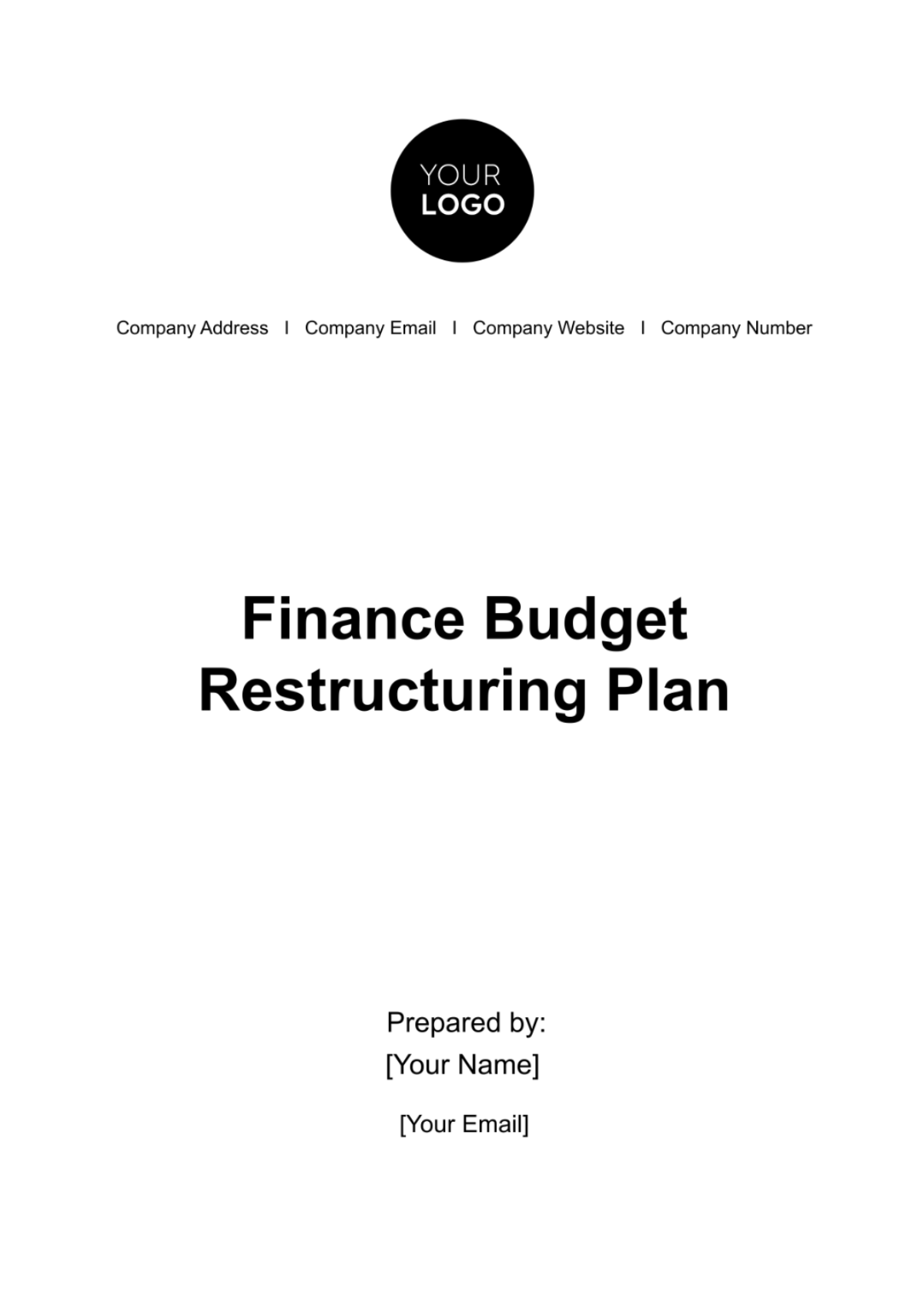
TABLE OF CONTENTS
I. Executive Summary
II. Current Financial Assessment
A. Analysis of Current Budget
B. Performance Evaluation
III. Restructuring Strategy
A. Areas for Adjustment
B. Strategic Initiatives
IV. Implementation and Transition Plan
A. Action Plan
B. Transition Management
V. Monitoring and Review
A. Performance Metrics and KPIs
B. Regular Review Process
VI. Risk Management and Mitigation
A. Risk Identification
B. Mitigation Strategies
VII. Stakeholder Engagement and Communication
A. Communication Plan
B. Engagement Activities
I. Executive Summary
The Finance Budget Restructuring Plan for [Your Company Name] represents a comprehensive and strategic approach towards redefining our financial management to thrive in the current economic landscape. This plan is designed to address the immediate financial challenges posed by market volatility and capitalize on emerging opportunities that align with our long-term strategic objectives.
It seeks to rejuvenate [Your Company Name]'s financial strategy by reshaping our budgetary allocations and spending practices to foster sustainable growth and enhance operational efficiency. Emphasizing a proactive stance, the plan is tailored to navigate through complex economic terrains, ensuring that our financial resources are optimally utilized to support key business initiatives and long-term corporate stability.
Key Objectives
Central to this restructuring initiative are three primary objectives: enhancing cost efficiency across all departments, optimizing revenue streams to tap into new and existing market potentials, and reallocating resources to focus on high-growth and high-potential areas. The plan aims to dissect and rebuild our financial framework in a manner that not only addresses the immediate need for cost control and revenue maximization but also sets the stage for future growth and innovation.
By realigning our budget with these objectives, [Your Company Name] is positioned to respond adeptly to evolving market dynamics, improve our financial resilience, and carve a path towards achieving our strategic business outcomes. This restructuring is not just a fiscal adjustment; it's a strategic reorientation towards a more agile, responsive, and growth-focused financial operation.
II. Current Financial Assessment
This section provides a detailed assessment of [Your Company Name]'s current financial status, highlighting areas where our spending is not aligned with expected returns and identifying opportunities for strategic investment. It critically evaluates how the existing budget supports our key objectives of innovation and market expansion in the evolving economic landscape.
A. Analysis of Current Budget
Our in-depth analysis of the current budget at [Your Company Name] has uncovered significant insights. We have identified several areas where our expenditures are not yielding the expected return on investment, suggesting a need for reallocation or reduction in these areas. Particularly, certain operational costs, such as traditional marketing methods and some legacy systems, are consuming resources without commensurate benefits.
Simultaneously, there is a glaring gap in our investment in digital transformation. The current allocation towards digital initiatives is insufficient, considering the rapid pace at which market dynamics are evolving towards digital platforms.
B. Performance Evaluation
Evaluating the performance of our current budget against our set financial goals has highlighted a clear misalignment. The budget, in its existing form, is geared more towards maintaining the status quo rather than driving growth and innovation. This is particularly evident in the areas critical for future expansion and competitiveness, such as research and development, and digital market engagement.
While our current budget adequately covers essential operational needs, it lacks the strategic foresight and allocation required to propel [Your Company Name] into new markets and innovation frontiers. As a result, we are missing out on potential revenue streams and opportunities to establish a stronger foothold in emerging markets.
III. Restructuring Strategy
In this section, we provide a detailed breakdown of the costs associated with each project in [Your Company]'s capital budget proposal, along with a comprehensive plan for funding these investments. Our approach balances various funding sources to maintain financial stability while pursuing these strategic initiatives.
A. Areas for Adjustment
Key areas identified for restructuring include marketing and advertising, research and development, and IT infrastructure. The plan proposes a decrease in traditional marketing expenses, a targeted approach in R&D spending, and a significant increase in IT investments.
Areas for Adjustment | Proposed Changes | Rationale |
|---|---|---|
Marketing and Advertising | Decrease traditional marketing expenses by [20%] | To shift focus towards more effective digital marketing strategies |
Research and Development (R&D) | Target R&D spending to specific high-impact projects | To ensure R&D funds are utilized for projects with the highest potential for returns and market relevance |
IT Infrastructure | Increase IT investment by 30% | To support digital transformation initiatives and modernize operations |
B. Strategic Initiatives
Strategic initiatives include implementing cost-saving measures through operational streamlining, investing in digital marketing for higher ROI, and reallocating funds to IT for digital transformation initiatives. These measures are designed to enhance efficiency, drive revenue growth, and support strategic business objectives.
Strategic Initiatives | Action Plan | Expected Outcomes |
|---|---|---|
Cost-Saving through Operational Streamlining | Implement lean management techniques across all departments | Improved operational efficiency and reduced unnecessary expenditures |
Investing in Digital Marketing | Allocate additional funds to SEO, social media, and online advertising | Increased online visibility, customer engagement, and higher ROI |
IT for Digital Transformation | Upgrade existing systems, adopt cloud services, enhance cybersecurity | Enhanced operational agility, improved data management, and robust security protocols |
IV. Implementation and Transition Plan
This section details the action plan and transition management strategies for effectively implementing the Finance Budget Restructuring Plan at [Your Company Name]. The plan is structured to be rolled out in phases over the next two quarters, ensuring a smooth transition with minimal disruption to ongoing operations.
A. Action Plan
The implementation will be phased over the next two quarters. Initially, departmental budgets will be revised, followed by the rollout of new spending policies. The final phase involves investing in IT infrastructure and digital capabilities.
Phase | Duration | Key Activities | Responsible Departments |
|---|---|---|---|
Phase 1: Departmental Budget Revision | Month 1-2 | Review and revise departmental budgets in line with restructuring goals | Finance, All Departments |
Phase 2: Policy Rollout | Month 3-4 | Implement new spending policies and procedures; | Finance, Human Resources |
Phase 3: IT and Digital Investments | Month 5-6 | Begin investments in IT infrastructure upgrades | IT, Marketing |
B. Transition Management
Effective transition management will involve clear communication with all stakeholders, training programs for employees to adapt to new systems and processes, and close monitoring of the implementation process to ensure minimal operational disruption.
Strategy | Activities | Expected Outcomes |
|---|---|---|
Stakeholder Communication | Regular updates and briefings to all stakeholders about the changes | Clear understanding of the restructuring process and timeline; gaining stakeholder buy-in |
Employee Training and Support | Comprehensive training programs for new systems and processes | Smooth adaptation to new policies and technologies; maintaining productivity and morale |
Close Monitoring and Adjustment | Ongoing monitoring of the implementation process; adjusting strategies as needed | Minimizing operational disruption; ensuring the restructuring aligns with company goals |
The implementation and transition plan for [Your Company Name]'s budget restructuring is meticulously designed to ensure effective execution and seamless integration into our daily operations. By phasing the implementation, providing clear communication, and supporting our employees through this change, we aim to minimize disruption and maximize the effectiveness of our new budget structure.
V. Monitoring and Review
In this section, we establish a robust framework for monitoring and reviewing the outcomes of the Finance Budget Restructuring Plan at [Your Company Name]. Using specific performance metrics and a regular review process, this approach ensures that our restructuring efforts are continuously aligned with our strategic objectives and responsive to market and operational dynamics.
A. Performance Metrics and KPIs
For a comprehensive assessment of the restructuring plan's effectiveness, we have identified key performance indicators (KPIs) that span various aspects of [Your Company Name]'s operations. These include measuring cost savings achieved through our streamlined processes, monitoring revenue growth particularly from new digital initiatives, evaluating improvements in operational efficiency post-implementation, and assessing the return on investment (ROI) from our enhanced IT infrastructure. Tracking these metrics will provide us with quantifiable insights into the success of our restructuring efforts, allowing us to measure progress against our predefined objectives and make data-driven decisions.
B. Regular Review Process
To ensure the restructuring plan remains effective and relevant, a bi-annual review process will be instituted. This structured approach involves analyzing the performance data against our set KPIs, evaluating the impact of the budget changes on our overall business strategy, and understanding how external market trends might influence our operational performance.
These reviews will serve as checkpoints to gauge the success of the implemented changes and to identify areas requiring further adjustments. The flexibility of this review process allows us to adapt and refine our budgeting strategy in response to changing market conditions, emerging business opportunities, or shifts in our strategic direction, thereby maintaining the agility and resilience of [Your Company Name]'s financial structure.
VI. Risk Management and Mitigation
This section outlines a comprehensive risk management strategy to proactively identify and address potential risks associated with the Finance Budget Restructuring Plan at [Your Company Name]. It focuses on the preemptive identification of risks and the implementation of effective mitigation strategies to ensure the plan's successful execution.
A. Risk Identification
The process begins with a thorough analysis to identify potential risks in each area of the restructuring plan. Key risks include operational disruptions during transition phases, resistance to change from employees, technological integration challenges, and potential misalignment of the revised budget with unforeseen market changes.
B. Mitigation Strategies
For each identified risk, specific mitigation strategies are developed:
Operational Disruptions: Implement transition management practices, including phased rollouts and contingency planning.
Employee Resistance: Foster open communication and engagement initiatives to ensure buy-in and smooth adaptation to changes.
Technological Challenges: Partner with experienced IT providers and conduct thorough testing before full-scale implementation.
Market Misalignment: Establish a flexible and adaptive budgeting approach, allowing for quick response to market shifts.
VII. Stakeholder Engagement and Communication
Effective communication and stakeholder engagement are critical for the success of the restructuring plan. This section outlines the strategies for maintaining transparent and continuous communication with all stakeholders involved, ensuring their support and cooperation throughout the restructuring process.
A. Communication Plan
A detailed communication plan will be developed, outlining the frequency, channels, and content of communications to different stakeholder groups, including employees, management, board members, investors, and customers. Regular updates, informative sessions, and feedback mechanisms will be integral components of this plan.
B. Engagement Activities
To foster a sense of involvement and buy-in, various stakeholder engagement activities will be conducted:
Employee Workshops: Interactive sessions to educate employees about the changes and their benefits.
Management Briefings: Regular briefings to keep management informed and aligned with the restructuring objectives.
Investor Meetings: Periodic meetings with investors to present the progress and impact of the restructuring on business outcomes.
Customer Communications: Updates to customers on how the restructuring will enhance service quality and efficiency.
- 100% Customizable, free editor
- Access 1 Million+ Templates, photo’s & graphics
- Download or share as a template
- Click and replace photos, graphics, text, backgrounds
- Resize, crop, AI write & more
- Access advanced editor
Take control of your financial journey with Template.net's Finance Budget Restructuring Plan. A customizable, editable tool designed for everyone. Adjust and organise your budget with ease within our Ai Editor Tool. Promising to simplify your fiscal planning, this essential tool will give you control. Step into efficient financial management now.
You may also like
- Finance Plan
- Construction Plan
- Sales Plan
- Development Plan
- Career Plan
- Budget Plan
- HR Plan
- Education Plan
- Transition Plan
- Work Plan
- Training Plan
- Communication Plan
- Operation Plan
- Health And Safety Plan
- Strategy Plan
- Professional Development Plan
- Advertising Plan
- Risk Management Plan
- Restaurant Plan
- School Plan
- Nursing Home Patient Care Plan
- Nursing Care Plan
- Plan Event
- Startup Plan
- Social Media Plan
- Staffing Plan
- Annual Plan
- Content Plan
- Payment Plan
- Implementation Plan
- Hotel Plan
- Workout Plan
- Accounting Plan
- Campaign Plan
- Essay Plan
- 30 60 90 Day Plan
- Research Plan
- Recruitment Plan
- 90 Day Plan
- Quarterly Plan
- Emergency Plan
- 5 Year Plan
- Gym Plan
- Personal Plan
- IT and Software Plan
- Treatment Plan
- Real Estate Plan
- Law Firm Plan
- Healthcare Plan
- Improvement Plan
- Media Plan
- 5 Year Business Plan
- Learning Plan
- Marketing Campaign Plan
- Travel Agency Plan
- Cleaning Services Plan
- Interior Design Plan
- Performance Plan
- PR Plan
- Birth Plan
- Life Plan
- SEO Plan
- Disaster Recovery Plan
- Continuity Plan
- Launch Plan
- Legal Plan
- Behavior Plan
- Performance Improvement Plan
- Salon Plan
- Security Plan
- Security Management Plan
- Employee Development Plan
- Quality Plan
- Service Improvement Plan
- Growth Plan
- Incident Response Plan
- Basketball Plan
- Emergency Action Plan
- Product Launch Plan
- Spa Plan
- Employee Training Plan
- Data Analysis Plan
- Employee Action Plan
- Territory Plan
- Audit Plan
- Classroom Plan
- Activity Plan
- Parenting Plan
- Care Plan
- Project Execution Plan
- Exercise Plan
- Internship Plan
- Software Development Plan
- Continuous Improvement Plan
- Leave Plan
- 90 Day Sales Plan
- Advertising Agency Plan
- Employee Transition Plan
- Smart Action Plan
- Workplace Safety Plan
- Behavior Change Plan
- Contingency Plan
- Continuity of Operations Plan
- Health Plan
- Quality Control Plan
- Self Plan
- Sports Development Plan
- Change Management Plan
- Ecommerce Plan
- Personal Financial Plan
- Process Improvement Plan
- 30-60-90 Day Sales Plan
- Crisis Management Plan
- Engagement Plan
- Execution Plan
- Pandemic Plan
- Quality Assurance Plan
- Service Continuity Plan
- Agile Project Plan
- Fundraising Plan
- Job Transition Plan
- Asset Maintenance Plan
- Maintenance Plan
- Software Test Plan
- Staff Training and Development Plan
- 3 Year Plan
- Brand Activation Plan
- Release Plan
- Resource Plan
- Risk Mitigation Plan
- Teacher Plan
- 30 60 90 Day Plan for New Manager
- Food Safety Plan
- Food Truck Plan
- Hiring Plan
- Quality Management Plan
- Wellness Plan
- Behavior Intervention Plan
- Bonus Plan
- Investment Plan
- Maternity Leave Plan
- Pandemic Response Plan
- Succession Planning
- Coaching Plan
- Configuration Management Plan
- Remote Work Plan
- Self Care Plan
- Teaching Plan
- 100-Day Plan
- HACCP Plan
- Student Plan
- Sustainability Plan
- 30 60 90 Day Plan for Interview
- Access Plan
- Site Specific Safety Plan

